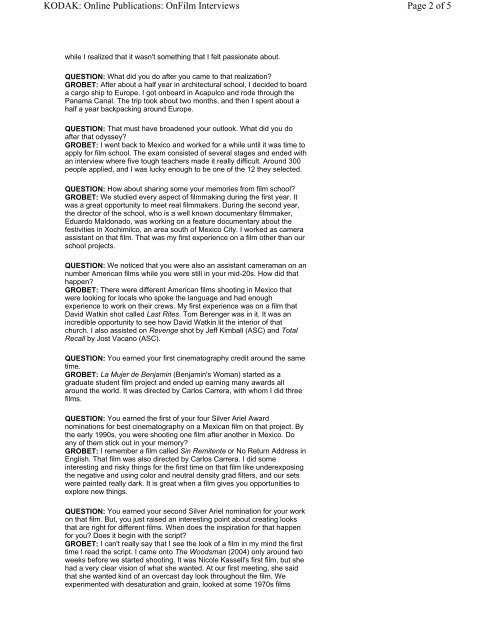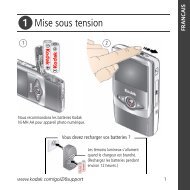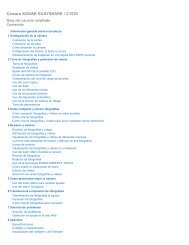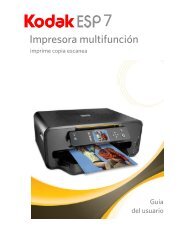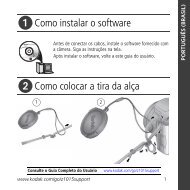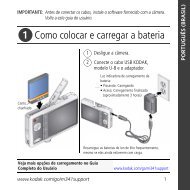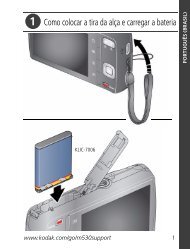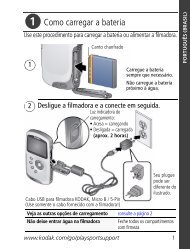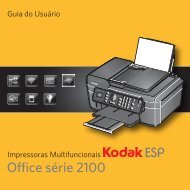OnFilm Interviews A Conversation with Xavier Pérez Grobet ... - Kodak
OnFilm Interviews A Conversation with Xavier Pérez Grobet ... - Kodak
OnFilm Interviews A Conversation with Xavier Pérez Grobet ... - Kodak
You also want an ePaper? Increase the reach of your titles
YUMPU automatically turns print PDFs into web optimized ePapers that Google loves.
KODAK: Online Publications: <strong>OnFilm</strong> <strong>Interviews</strong><br />
while I realized that it wasn't something that I felt passionate about.<br />
QUESTION: What did you do after you came to that realization?<br />
GROBET: After about a half year in architectural school, I decided to board<br />
a cargo ship to Europe. I got onboard in Acapulco and rode through the<br />
Panama Canal. The trip took about two months, and then I spent about a<br />
half a year backpacking around Europe.<br />
QUESTION: That must have broadened your outlook. What did you do<br />
after that odyssey?<br />
GROBET: I went back to Mexico and worked for a while until it was time to<br />
apply for film school. The exam consisted of several stages and ended <strong>with</strong><br />
an interview where five tough teachers made it really difficult. Around 300<br />
people applied, and I was lucky enough to be one of the 12 they selected.<br />
QUESTION: How about sharing some your memories from film school?<br />
GROBET: We studied every aspect of filmmaking during the first year. It<br />
was a great opportunity to meet real filmmakers. During the second year,<br />
the director of the school, who is a well known documentary filmmaker,<br />
Eduardo Maldonado, was working on a feature documentary about the<br />
festivities in Xochimilco, an area south of Mexico City. I worked as camera<br />
assistant on that film. That was my first experience on a film other than our<br />
school projects.<br />
QUESTION: We noticed that you were also an assistant cameraman on an<br />
number American films while you were still in your mid-20s. How did that<br />
happen?<br />
GROBET: There were different American films shooting in Mexico that<br />
were looking for locals who spoke the language and had enough<br />
experience to work on their crews. My first experience was on a film that<br />
David Watkin shot called Last Rites. Tom Berenger was in it. It was an<br />
incredible opportunity to see how David Watkin lit the interior of that<br />
church. I also assisted on Revenge shot by Jeff Kimball (ASC) and Total<br />
Recall by Jost Vacano (ASC).<br />
QUESTION: You earned your first cinematography credit around the same<br />
time.<br />
GROBET: La Mujer de Benjamin (Benjamin's Woman) started as a<br />
graduate student film project and ended up earning many awards all<br />
around the world. It was directed by Carlos Carrera, <strong>with</strong> whom I did three<br />
films.<br />
QUESTION: You earned the first of your four Silver Ariel Award<br />
nominations for best cinematography on a Mexican film on that project. By<br />
the early 1990s, you were shooting one film after another in Mexico. Do<br />
any of them stick out in your memory?<br />
GROBET: I remember a film called Sin Remitente or No Return Address in<br />
English. That film was also directed by Carlos Carrera. I did some<br />
interesting and risky things for the first time on that film like underexposing<br />
the negative and using color and neutral density grad filters, and our sets<br />
were painted really dark. It is great when a film gives you opportunities to<br />
explore new things.<br />
QUESTION: You earned your second Silver Ariel nomination for your work<br />
on that film. But, you just raised an interesting point about creating looks<br />
that are right for different films. When does the inspiration for that happen<br />
for you? Does it begin <strong>with</strong> the script?<br />
GROBET: I can't really say that I see the look of a film in my mind the first<br />
time I read the script. I came onto The Woodsman (2004) only around two<br />
weeks before we started shooting. It was Nicole Kassell's first film, but she<br />
had a very clear vision of what she wanted. At our first meeting, she said<br />
that she wanted kind of an overcast day look throughout the film. We<br />
experimented <strong>with</strong> desaturation and grain, looked at some 1970s films<br />
Page 2 of 5


